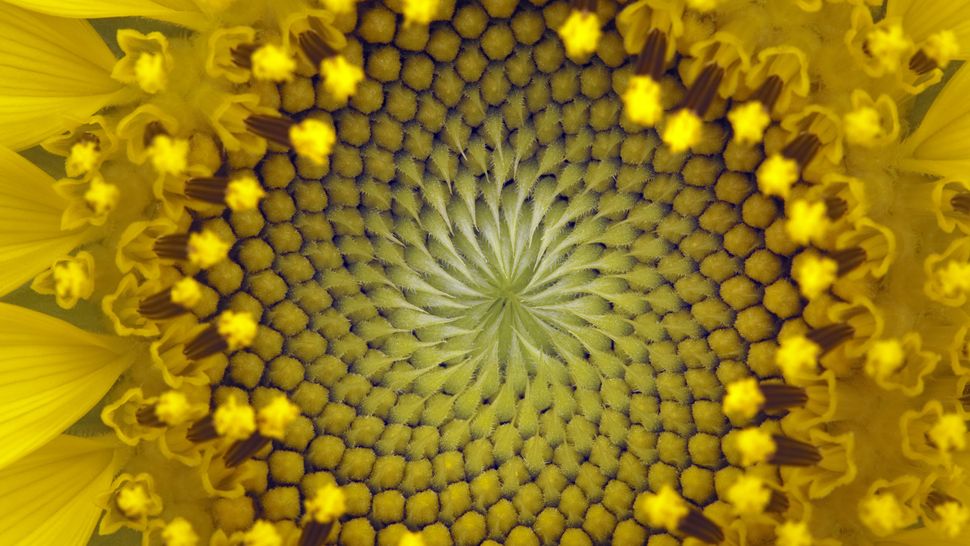Science
Related: About this forumWhat is the Fibonacci sequence?
By Tia Ghose published about 9 hours ago
From its origins to its significance, almost every popular notion about the famous Fibonacci sequence is wrong.

The seeds in a sunflower exhibit a golden spiral, which is tied to the Fibonacci sequence. (Image credit: belterz/Getty Images)
The Fibonacci sequence is a series of numbers in which each number is the sum of the two that precede it. Starting at 0 and 1, the sequence looks like this: 0, 1, 1, 2, 3, 5, 8, 13, 21, 34, and so on forever. The Fibonacci sequence can be described using a mathematical equation: Xn+2= Xn+1 + Xn
People claim there are many special properties about the numerical sequence, such as the fact that it is “nature’s secret code” for building perfect structures, like the Great Pyramid at Giza or the iconic seashell that likely graced the cover of your school mathematics textbook. But much of that is incorrect and the true history of the series is a bit more down-to-earth.
The first thing to know is that the sequence is not originally Fibonacci's, who in fact never went by that name. The Italian mathematician who we call Leonardo Fibonacci was born around 1170, and originally known as Leonardo of Pisa, said Keith Devlin, a mathematician at Stanford University.
. . .
Leonardo of Pisa did not actually discover the sequence, said Devlin, who is also the author of "Finding Fibonacci: The Quest to Rediscover the Forgotten Mathematical Genius Who Changed the World," (Princeton University Press, 2017). Ancient Sanskrit texts that used the Hindu-Arabic numeral system first mention it in 200 B.C. predating Leonardo of Pisa by centuries.
More:
https://www.livescience.com/37470-fibonacci-sequence.html?utm_source=notification
abqtommy
(14,118 posts)world today. I was taught in school that the Arab mathematicians gave us the number "0".
YP_Yooper
(291 posts)Humanity’s discovery of zero was “a total game changer ... equivalent to us learning language,” says Andreas Nieder, a cognitive scientist at the University of Tübingen in Germany.
But for the vast majority of our history, humans didn’t understand the number zero. It’s not innate in us. We had to invent it. And we have to keep teaching it to the next generation.
Robert Kaplan, author of The Nothing That Is: A Natural History of Zero and former professor of mathematics at Harvard University, provides this answer:
The first evidence we have of zero is from the Sumerian culture in Mesopotamia, some 5,000 years ago. There, a slanted double wedge was inserted between cuneiform symbols for numbers, written positionally, to indicate the absence of a number in a place (as we would write 102, the '0' indicating no digit in the tens column). https://www.scientificamerican.com/article/what-is-the-origin-of-zer/
Andreas Nieder, the cognitive scientist from Germany, hypothesizes there are four psychological steps to understand zero, and each step is more cognitively complicated than the one before it. https://www.vox.com/science-and-health/2018/7/5/17500782/zero-number-math-explained
intrepidity
(7,294 posts)Spontaneous representation of numerosity zero in a deep neural network for visual object recognition
https://www.sciencedirect.com/science/article/pii/S2589004221012700
SCantiGOP
(13,869 posts)Can’t remember which one, where they asked people in the street if we should be teaching Arabic numbers in schools, and, of course there were people who thought it wasn’t a good idea.
![]()
CaliforniaPeggy
(149,588 posts)Judi Lynn
(160,516 posts)Had never noticed the backside of a sunflower before seeing it. So interesting realizing it is beautifully formed, as well.
Thank you for sharing the video, California Peggy.

Incipient sunflower!

Who knew sunflowers were so special!
electric_blue68
(14,886 posts)mitch96
(13,892 posts)It pops up in a number of places and even used in photography..
I got so weird about it I even found a craftsman who made a "golden ratio" caliper and bought one.. Neat toy and great conversation piece...
m
https://www.nationalgeographic.org/media/golden-ratio/

dsharp88
(487 posts)I hear it’s going to be as good as the last two combined!
Response to Judi Lynn (Original post)
traitorsgalore This message was self-deleted by its author.
Jim__
(14,075 posts)From the paper referenced in the op:
Quanta has an article on Mathematical Physics, Euler’s 243-Year-Old ‘Impossible’ Puzzle Gets a Quantum Solution. A short description of Euler's puzzle from the article:

In 1779, the Swiss mathematician Leonhard Euler posed a puzzle that has since become famous: Six army regiments each have six officers of six different ranks. Can the 36 officers be arranged in a 6-by-6 square so that no row or column repeats a rank or regiment?
The puzzle is easily solved when there are five ranks and five regiments, or seven ranks and seven regiments. But after searching in vain for a solution for the case of 36 officers, Euler concluded that “such an arrangement is impossible, though we can’t give a rigorous demonstration of this.” More than a century later, the French mathematician Gaston Tarry proved that, indeed, there was no way to arrange Euler’s 36 officers in a 6-by-6 square without repetition. In 1960, mathematicians used computers to prove that solutions exist for any number of regiments and ranks greater than two, except, curiously, six.
Similar puzzles have entranced people for more than 2,000 years. Cultures around the world have made “magic squares,” arrays of numbers that add to the same sum along each row and column, and “Latin squares” filled with symbols that each appear once per row and column. These squares have been used in art and urban planning, and just for fun. One popular Latin square — Sudoku — has subsquares that also lack repeating symbols. Euler’s 36 officers puzzle asks for an “orthogonal Latin square,” in which two sets of properties, such as ranks and regiments, both satisfy the rules of the Latin square simultaneously.
...
Some physicists have found a solution to Euler's puzzle, provided that the officers can have a quantum mixture of ranks and regiments. And:
electric_blue68
(14,886 posts)to 13 x 13 squares.
Not sure if I figured out where to start on a graph to get to 21 x 21 squares. Maybe I'd have to work backward. 😄
Very satisfying to draw! 💖